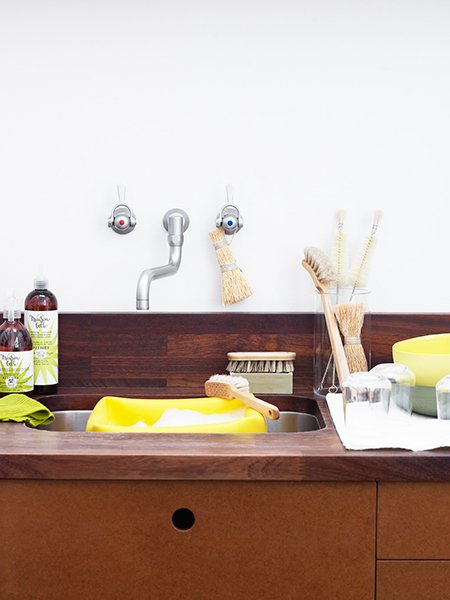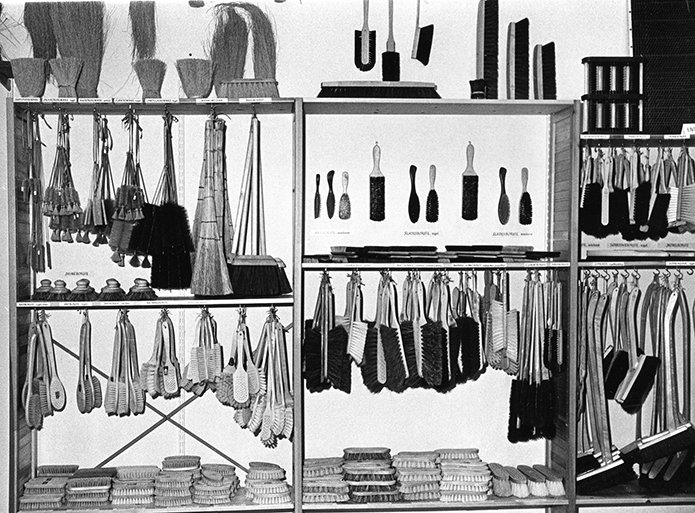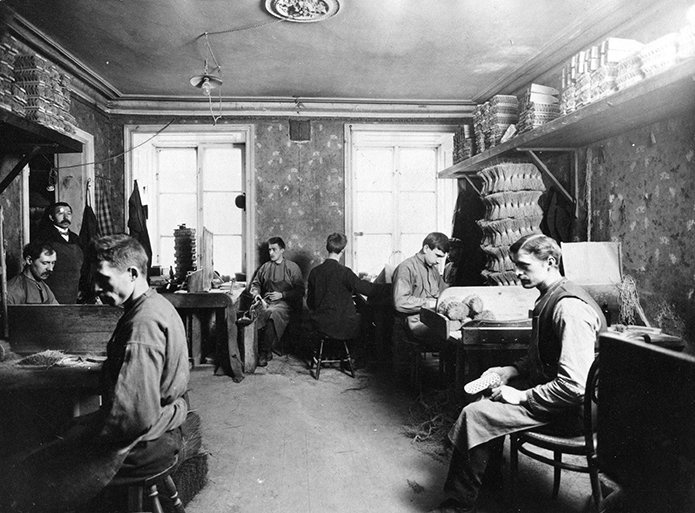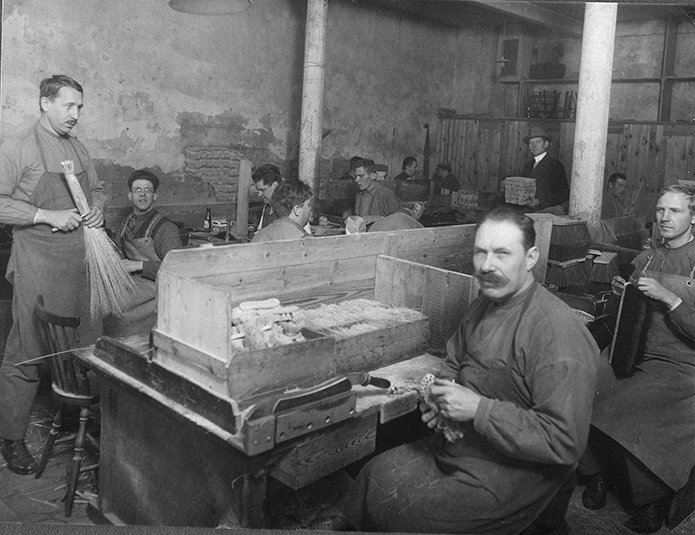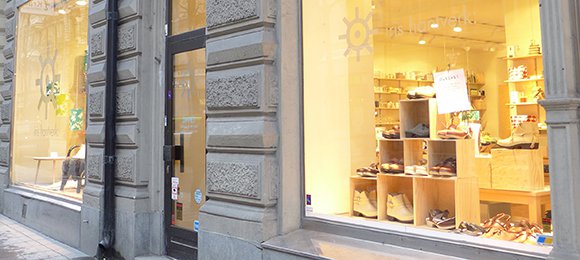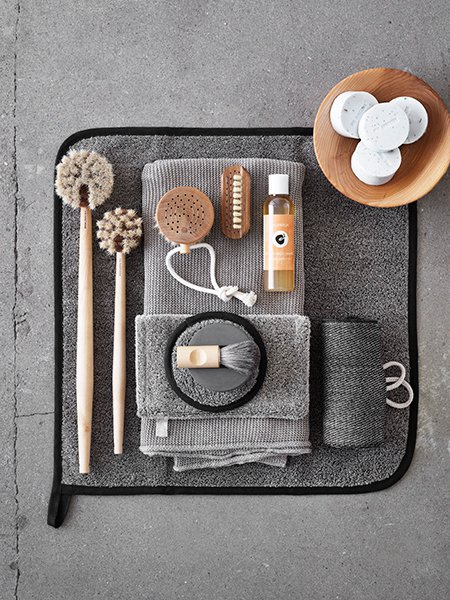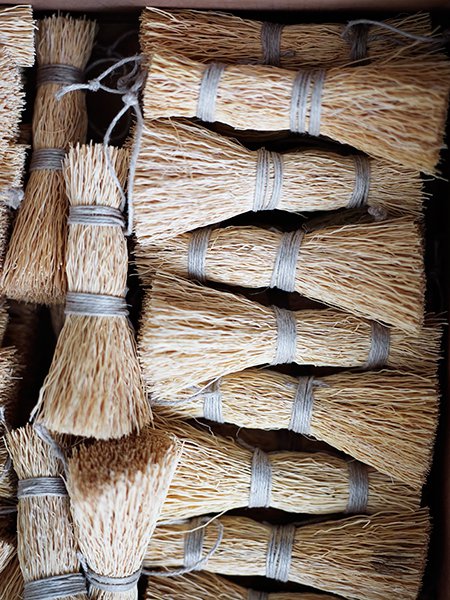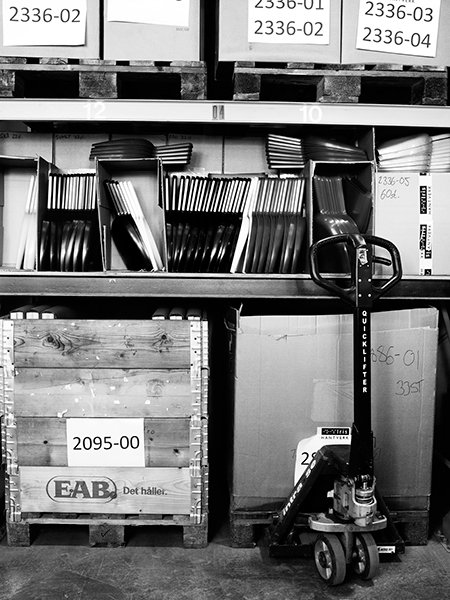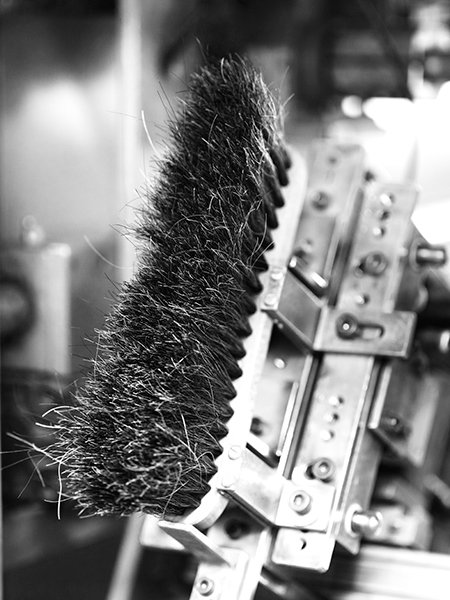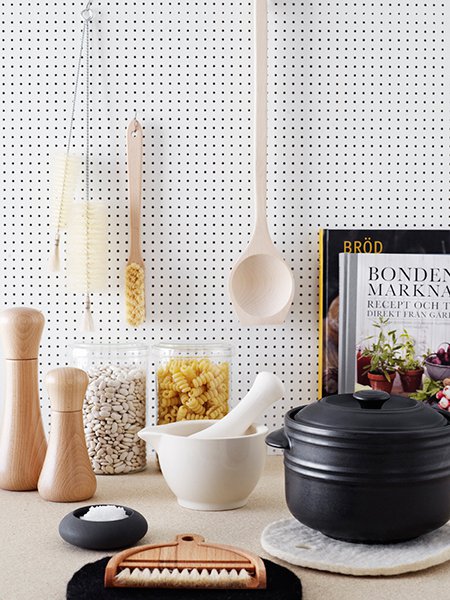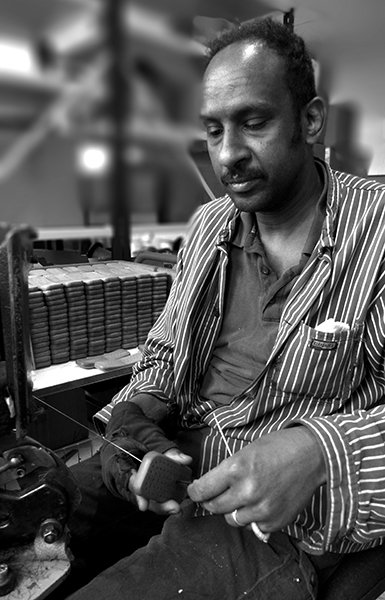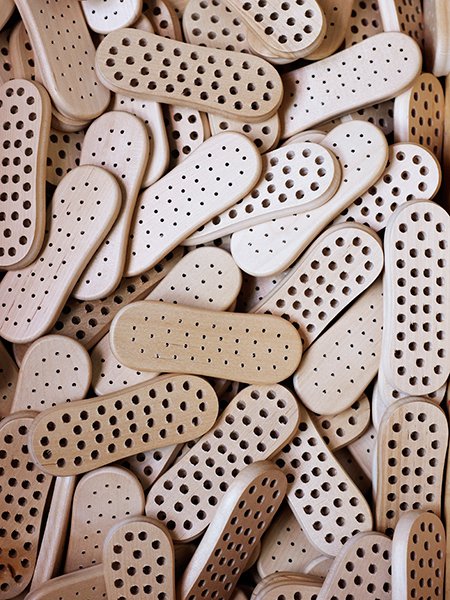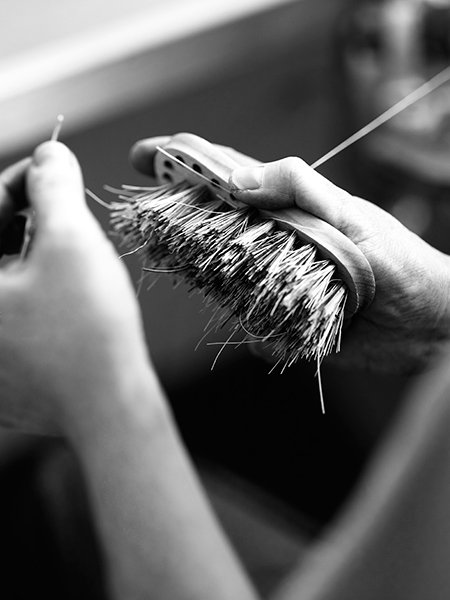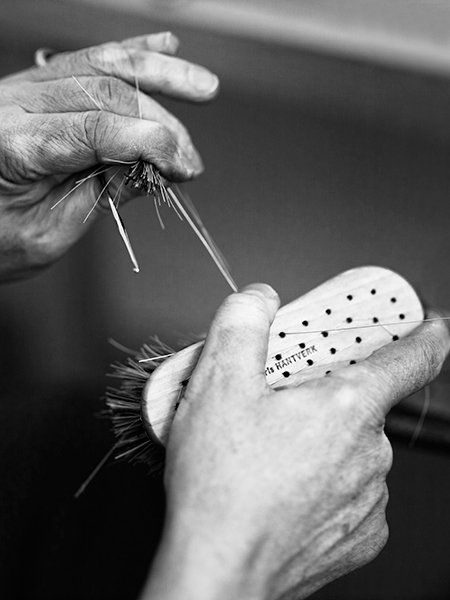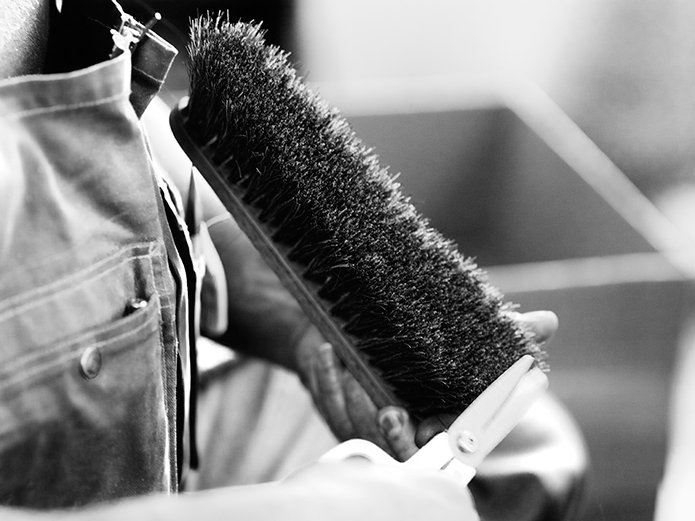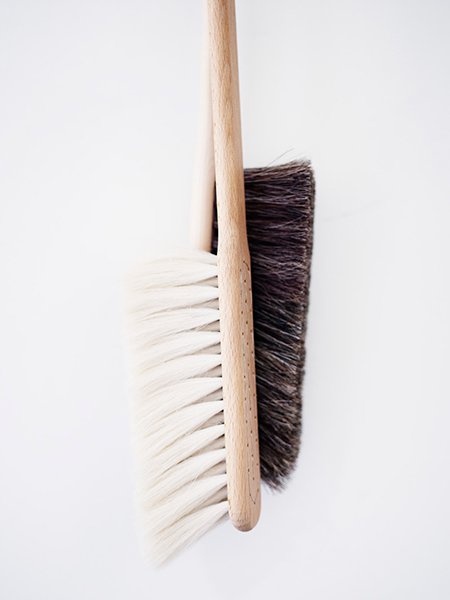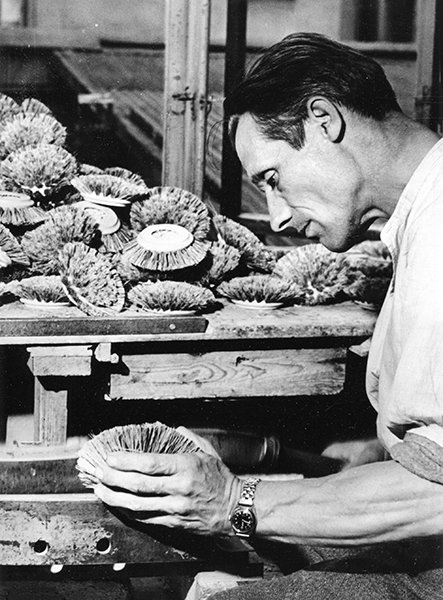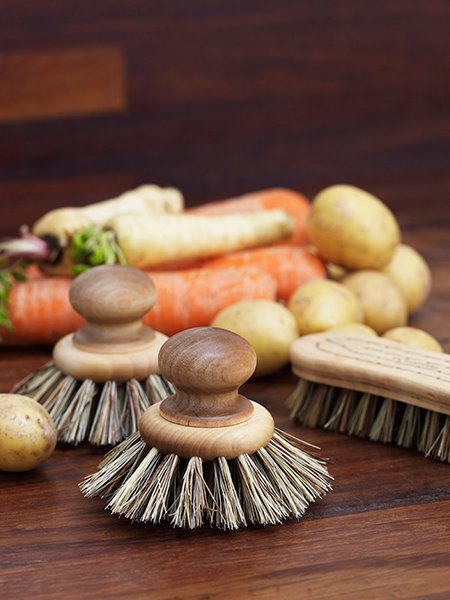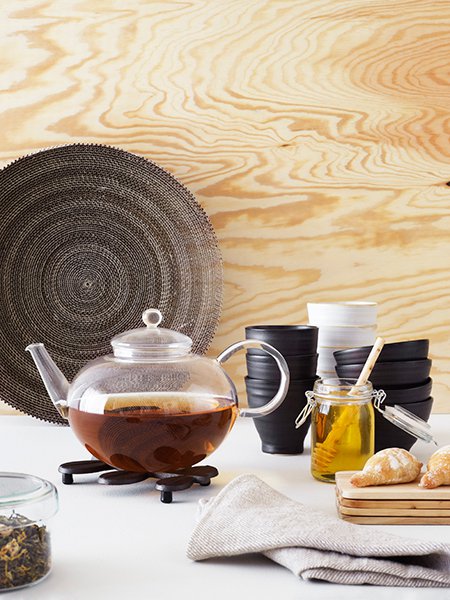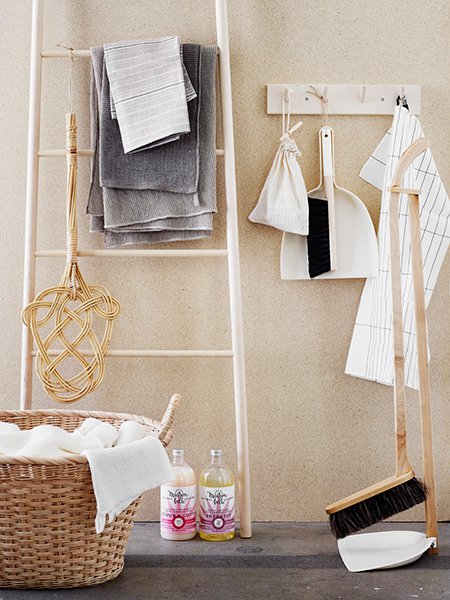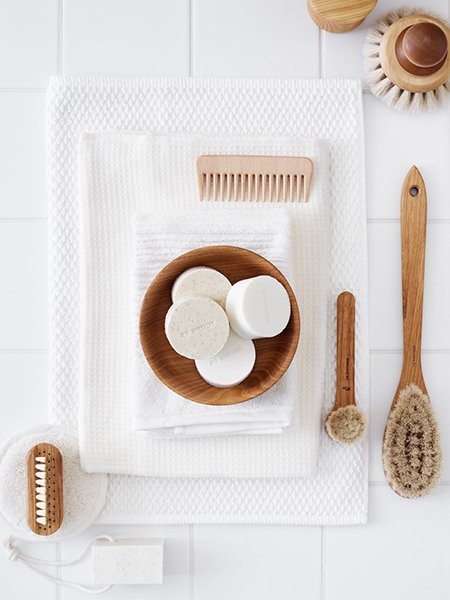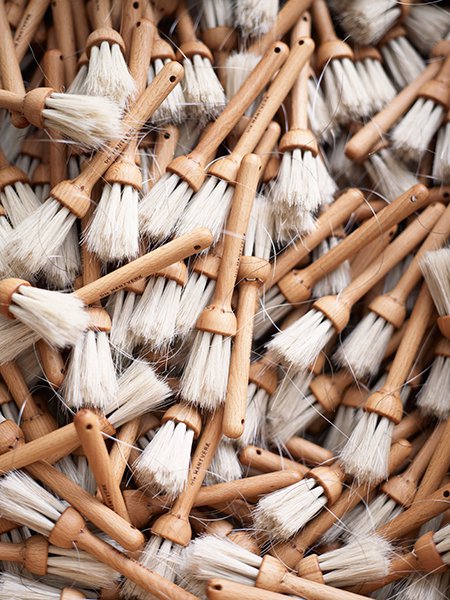
Objects that are practical, pleasing to the eye, pleasant to hold and pertinent are few and far between in this day and age, however Iris Hantverk brushes are all of those things. This range of beautiful brushes – from kitchen scourers & vegetable scrubbers, to clothes & body brushes – has its roots in heritage, craftsmanship and philanthropy dating back to the late 19th Century when Sweden’s De Blindas Förening (The Blind Association) set up a brush-making collective of visually-impaired craftsman (which would later become Iris Hantverk), to provide equal opportunities for the blind and partially sighted. These brush-makers, with previously limited opportunities to earn a living, were able to purchase the raw materials at cost price and, either working in the factory or from home, handcraft all manner of brushes in demand in Sweden at that time.
Since then, although the demand for hand-crafted brushes has diminished around the world with the rise of plastic, there is still demand for authentic Iris Hantverk products; as well as two retail outlets in Stockholm and a new website, Iris Hantverk distributes widely across Europe & North America and as far afield as Far East & Australia. The original ethos remains constant with a commitment to craftsmanship and equal opportunities for the visually impaired as well as socially and environmentally responsible sourcing of natural materials, including FSC-certified Swedish hardwoods and sustainable animal hair and plant fibre bristles from Europe and Central America, which, amongst discerning and responsible consumers, is, thankfully, a growing market.
However, it hasn’t been easy. With cancelled Government funding and threat of closure due to retirement of the previous owner, Iris Hantverk has been through a tumultuous time in recent years. Yet new owners, Richard Sparrenhök & Sara Edhäll, previous long-standing employees, have revitalised the company whilst remaining loyal to the legacy, and have succeeded in expanding the market, increasing turnover and securing funding from responsibly-minded corporate fans, such as UK retailer John Lewis, to not only survive, but to flourish. Iris Hantverk has remained as solid and durable as its brushes.
Here, Sara Edhäll, talks to us about what it means to be a successful social enterprise creating beautiful objects that are beneficial to both the craftsman and consumer…
Firstly, for those readers who aren’t familiar with Iris Hantverk, please can you tell us what you do?
Our core business is to make and sell brushes made by hand by visually-impaired craftsmen. Besides that we also carry a complementary assortment of design items for the home. We have two stores in Stockholm, Sweden and about 800 retailers around the world selling Iris Hantverk products.
You have a rich history of working with blind and visually-impaired craftsmen dating back to the 19th Century. Can you provide an insight into the background of your company?
Iris Hantverk has been closely associated with the visually impaired in Sweden since the 19th Century. This was a time in Sweden’s history when large numbers of people made the transition from working in agriculture to industry, moving in large numbers to the cities, and the labour movement emerged in tandem with this.
In 1870, Dr. Axel Beskov founded the Manilla School, which was a workhouse for visually-impaired craftsmen in Stockholm. Life was tough, as work began at 6 am and finished at 9 pm.
In 1889 an organisation was formed by a group of visually-impaired craftsman called “De Blindas Förening” [the ‘Blind Association’], whose aim was to encourage the visually impaired across Sweden to actively partake in society, from a social perspective, i.e. musical events and lectures, as well as through employment, whereby members of the association were encouraging equal access to work opportunities and being able to live by their workplace.
Increasingly the DBF’s focus became more involved with developing support for craftsmen and their ability to live off their work. In 1902, the DBF decided that, in the interests of visually-impaired craftsmen involved in brush binding and basket making, the materials used in these crafts would be purchased collectively in order to reduce prices, and sold to the individual craftsmen for the purchase price. At this time, many of the visually-impaired craftsmen involved in brush-binding would sit in their homes making brushes, and would have been forced to buy their raw materials individually at higher prices from their respective suppliers, as they could get the economies of scale, so this development was a real help for them.
In 1906 a property dedicated to brush binding for the visually-impaired was purchased which became the foundation for Iris Hantverk. The building accommodated a number of functions including a factory, warehouse, an area dedicated to the sales of raw materials, an office, a library and a shop.
Iris Hantverk employed about a hundred craftsmen at this time, based in the factory, as well as working from their homes, and the demand for their products – for cleaning, bath brushes and outdoor brushes, as well as baskets, which the craftsman also made back then – was high, as this was a time before the plastic revolution, and everyone used handcrafted products in Sweden.
Over the decades, the make-up of the workforce has changed, and the craftsmen working for us in outlying locations discontinued as the unions decided it wasn’t possible for craftsmen to work in their own homes without all the normal workplace facilities being made available. This significantly reduced the number of craftsmen working for us, although we are still able to sell raw materials to independent craftsmen across the country for the use in their own brushes.
We’re no longer in the same factory as we once were, and instead of the factory shop, we have two retail stores within the centre of Stockholm which we opened in the 1980s, but the visually-impaired movement and the hand-crafted nature of our products is engrained in our ethos.
Can you define the uniqueness of your brushes and why they are so special?
The design has naturally enveloped over the years but it has always focused on functional design and carefully selected natural materials. Our designs strive to be pleasing to the eyes and at the same time be very tactile. All brushes are specially designed to sit well in your hand, with bristles suitable for their particular area of use.
How important is the quality of materials in creating your brushes, and from where do you source these materials?
The quality of materials is absolutely essential. The keywords for our brand are: strong, solid and honest, and these terms are ensured at all levels. ‘Solid’ for us, among other things, means that our products are manufactured in a manner that is environmentally and socially sustainable. We have a responsibility towards everyone who contributes to making Iris Hantverk a successful business. Therefore, we see it as our responsibility to work closely with suppliers and business partners and to encourage all our business partners to adhere to social and environmental standards that are sustainable. We base our requirements mainly on internationally agreed standards such as the Universal Declaration of Human Rights, The UN Convention on the Rights of the Child and applicable ILO Conventions, as well as national legislation. Since most of our suppliers are from Sweden this is a matter of course.
We have worked with all of our suppliers for many years, most of them are Swedish companies, and we rely on their quality of work. However, the plant materials in the bristles don´t grow in Sweden so we import then from Mexico, Brazil and East Indies. Also the hair in the brushes is imported now, but many years ago, this would have been sourced in Sweden. We’ve been using the same two suppliers of bristles and hair for over fifty years.
The actual production of brushes has a natural low environmental impact since each brush is made by hand in natural materials, and all the wood that we use – oak, birch and beech – is FSC-certified Swedish hardwood.
The company went through a change of ownership a few years ago, with yourself and Richard Sparrenhök acquiring the company. What prompted this change and what impact has it had on the direction of the company?
Since the end of 19th Century, the company received a government grant to employ visually-impaired craftsmen, but by the mid-2000s the government began to discuss ending this support. A three-year cost reduction plan was set up in order to give the company a chance to adapt to the new conditions, and to help with this the company received funding from Synskadades Stiftelse [the ‘Visually Impaired Foundation’] and Kronprinsessan Margaretas Arbetsnämnd för synskadade [Princess Margareta’s Foundation for Visually Impaired] over the three-year period. This led to several years of toil to achieve profitability and several craftsmen were dismissed.
In 2012 the Socialdepartementet [‘Ministry of Health and Social Affairs’] withdraw the aid disbursed for depot activities for visually impaired craftsmen completely which had been the main revenue for that function since the 1950s which accounted for half of the company’s turnover at that time. A combination of changing company objectives and business perspectives made the incentive for the previous owner to continue further reduced.
Struggling for profitability Iris Hantverk’s owner decided to sell the company to us in August 2012. Both Richard and I had worked in the company for many years as managers, and so it made obvious sense for us to explore the option to acquire the company. Both Richard and I are delighted to have been able to take over and run the company, which holds so much history and tradition. We haven’t changed the focus, or made any changes, apart from opening an online shop in Sweden, as well as re-hiring one craftsman that we had regrettably previously dismissed as part of the previous cost-reduction plan.
Much of the success in turning the business around comes from the time and effort that you are able to put in when you run and own your own company.
Since you took over the company, have you received any external help and support to assist with training and infrastructure, or are you completely stand-alone now?
During these three years we have owned the company we have worked hard on expanding our business, reaching out to new markets and increasing the number of customers. This we have achieved by attending more trade fairs, such as Maison & Objet in Paris, Ambiente in Frankfurt and Spring Fair and Top Drawer in the UK, increased our visibility in social media and gained some influencing customers. This has successfully increased over turnover but since we have had loans to both to our previous owner and the bank we haven´t been able to put the necessary money in for starting to train more craftsmen.
But in June this year we were granted money from John Lewis and De Blindas Väl (‘Association Blind Pass’) which gave us the ability to employ 2 new craftsmen and start their training. The project with John Lewis was a one-time grant to cover the training period for one employee, which was dependent on match funding, which came from De Blindas Väl. John Lewis contacted us and said they loved what we do and were aware of the changes within the business and explained that we could apply for this grant to take on more people, which we were keen to do. I’m hoping this will be a catalyst for us to be able to self-fund the growth of the business and employ further craftsmen.
I imagine it’s quite a commitment building a business around producing the highest quality handcrafted brushes by a blind or visually-impaired workforce. How long does it take to train someone?
It takes about 6 months to train a new craftsman so that he/she is skilled enough to be a brush maker. They would start their training by sitting next to a master (someone who has been making brushes for over 20 years) and over the first 3 months the master will help the new person make brushes, correct them and teach them the high level of skill needed. Then it takes about 3 more months, when the trainee is sitting by him/herself making brushes, before the trainee has so much skill that he/she can make brushes with 100% quality.
By way of an insight into the artisanal nature of your work, could you briefly describe the process of crafting one of your brushes and explain some of the key stages in brush binding?
In simplistic terms, there are probably five key stages: making the wooden shape, drilling holes, oiling/waxing, attaching bristles/hair and cutting.
To start then, a piece of wood is sawed, milled, sanded and then oiled or waxed for its finish and protection. The holes for the bundle of bristles are drilled by a machine; the holes being smaller on the upper side of the brush and wider on the reverse underside where the bristles are. In a regular vegetable brush it’s about 40 holes that are drilled.
Each individual bundle of bristles is then attached to the base of the brush. The finished wood, thread and material – in the form of horse hair, goat hair, or vegetable fibres – are assembled.
The wire, usually a stainless steel wire, is pulled up in a loop through the narrowest end of the hole towards the wider end using a hook that is attached to a ring around the finger. Each individual bundle of bristles is placed in the wire loop and pulled into the larger hole.
The bundle of bristles is picked by hand from the pack of material, or sometimes a machine is used which dispenses out the right amount of material. When all the holes are filled with bristles the brush is cut and hackled to get them even and smooth, which is done by hand or with the help of a cutting machine.
…The result a beautiful brush!
All of our craftsmen are trained to produce the entire range of brushes, with the exception of a couple of brush designs that are incredibly complicated which only one of our craftsmen works on.
Your brush designs are very beautiful and distinctive. Are these all based on traditional Swedish designs or are you working with contemporary designers for new design ideas?
We have a few brushes still in production that are of traditional Swedish design which haven´t changed in look since we started back in the 1800s. The rest of the range comes from co-operation with independent designers, and during the years we have established a good relationship with a few that we work with on a regular basis. For us it is important to combine this traditional craft with design that fits in a modern home. Due to good and functional design most of our “new design” dates back 15-20 years.
You’re very well known as a manufacturer of handcrafted brushes, but I believe that isn’t all you sell. Can you talk about some of the other products in your range?
In addition to the brushes we make, we have developed a range of complementary products to sell which match the brushes in each of our main collections. In the kitchen, for example, this includes textiles, cutting boards, a series of bread storage boxes and hand-knitted potholders. In the bathroom we have textiles and concrete bowls for small items – just to mention a few things.
Most of the products are made here in Sweden; for example the bread boxes are manufactured at a small workshop, which is a daily activity and workplace for adults with mental disabilities. And the concrete bowls are moulded by hand in a small foundry in Tyresö, Stockholm.
How important is it to stay true to the original ethos of the company by only working with blind or visually impaired craftsmen?
Today, with advances in technology, there are lots of other work options that visually-impaired people can explore. But as always people have different capabilities so for some visually-impaired persons this traditional craft is the only employment option for them to earn their livelihood. So for us it is important to keep this job opportunity here in Sweden.
Our ability to stay true to this original ethos is only possible by working in collaboration with other similarly-minded businesses, such as our co-operation with visually-impaired craftsmen in Estonia, which began in 2011. Like us, they too have a history which is strongly connected to the visual impairments movement and who also lost their government funding around the same time as we did. We also have connections with visually-impaired craftsmen in Finland and Denmark, providing materials and buying some items such as the carpet beater. It’s good that the visually-impaired movements across various countries can work together and support each other.
As one of the last remaining producers of hand-crafted brushes made in the traditional way, what do you think are the main contributing factors for your success?
I think our ability to join really good design with excellent craftsmanship is the key factor. In more recent years, people’s newly awakened interest and attention to sustainability, locally-produced goods and manufacturing with good conditions for workers and environmental considerations, as a response to the ‘80-‘90s wear and tear, has really boosted the interest for our products. It feels very rewarding and is proof that what we do, and always have done, endures.
Finally, what future plans do you have for Iris Hantverk?
Our vision and goal is to get re-growth in this traditional craft. By bringing the expertise of artisans into the products, combining functionality and good design combined with the quality of the natural material, we would like more people in the world to appreciate the genuine craft of our products so that we can train and employ more craftsmen. This will involve developing our range of products, brushes being our main products, but other complementary products as well. We have a steady stream of new designs, which we look forward to launching.
Thanks to Sara Edhäll for taking time out of her busy schedule to answer our questions. All images © Iris Hantverk.



